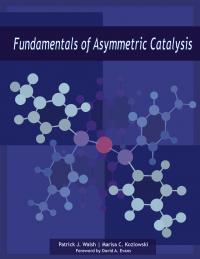Fundamentals of Asymmetric Catalysis
Fundamentals of Asymmetric Catalysis
By: Patrick J. Walsh, Marisa C. Kozlowski
This book describes the essential aspects of enantioselective catalysis in a clear, logical fashion, with chapters organized by concept rather than by reaction type.
For all sales outside of the United States, please contact Felicity Henson, fhenson@aip.org
Title information
The field of asymmetric catalysis plays an increasingly large role in chemical synthesis as the demand for single-enantiomer starting materials, intermediates, and products rises. This book describes the essential aspects of enantioselective catalysis in a clear, logical fashion, with chapters organized by concept rather than by reaction type. Each concept is supported by carefully selected examples to give the reader broad exposure to a wide range of catalysts, reactions, and reaction mechanisms.
This book is designed to introduce advanced undergraduate or graduate chemistry students to asymmetric catalysis. It can be used as the primary text in a course on this topic, or as a reference by researchers who wish to increase their understanding. It is also intended for synthetic chemists who wish to increase their likelihood for success when faced with the prospect of using asymmetric catalysts.
Contents
Introduction to Fundamentals of Asymmetric Catalysis
1. Modes of Asymmetric Induction
2. Lewis Acid and Lewis Base Catalysis
3. Beyond Lewis Acid and Lewis Base Catalysis
4. Asymmetric Induction in Enantioselective Catalysis
5. Nonclassical Two Point Catalyst Substrate Interactions
6. Chiral Poisoning, Chiral Activation, and Screening Achiral Ligands
7. Kinetic Resolution
8. Parallel Kinetic Resolution
9. Dynamic Kinetic Resolution and Dynamic Kinetic Asymmetric Transformations
10. Desymmetrization Reactions
11. Nonlinear Effects, Autocatalysis, and Autoinduction
12. Bifunctional, Dual, and Multifunctional Catalyst Systems
13. Asymmetric Catalysis with Homochiral Substrates: Double Diastereoselection
14. Multistep Asymmetric Catalysis
15. Supported Catalysts
16. Applications of Asymmetric Catalysis in Synthesis
Appendix
Index
|
“This fascinating book captures the diversity and applicability of an area of research that has emerged as one of the fastest growing fields in organic chemistry. As a text that addresses the major concepts of asymmetric catalysis, it could serve as an excellent aid for a university course…this book is destined to become a firm favorite for advanced and graduate students. Additionally, the book can be recommended to all scientists in academia and industry with an interest in asymmetric catalysis–as a source of information and for references. [It] is worth the price and should appear on many bookshelves and in many libraries.” “It is my opinion that this text will be widely accepted by the organic chemical community. There is nothing like it currently on the market. It reminds me of the Morrison & Mosher text, Asymmetric Synthesis, that was published more than three decades ago. The authors have generated the “New Bible” of asymmetric catalysis. The results are truly impressive and the cases are both relevant and current.” “This book is a great tool and “go to” book for students and practitioners interested in Asymmetric Synthesis.” “This is an impressive piece of scholarship that will be welcomed by the catalysis community.”
|

